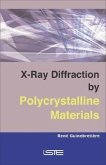1 Structures of and Bonding in Electronic Materials.- 1. Introduction.- 2. The Structure of the Group IV Elements and of III-V and II-VI Semiconductors.- 3. Bonding in and Relationships Between Zinc Blende and Wurtzite-Type Compounds.- 4. Other Structure Types.- References.- 2 Electron Energy Bands.- 1. Introduction.- 2. Models.- 2.1. The Nearly Free Electron Model.- 2.2. The Tight-Binding Model.- 2.3. The Relationship Between the Results of the Two Models.- 2.4. The Relationship Between Maximum Energy and k.- 2.5. Three-Dimensional Effects.- 2.6. Real Materials.- 3. Effective Mass.- 4. Positive Holes.- 5. Methods of Computing Band Structure.- 6. Conductance, the Octet Rule, and Bands.- 7. Postscript: The Kronig-Penney Model.- References.- 3 Electrical Properties of Semiconductors.- 1. Introduction.- 2. Intrinsic Semiconductors.- 3. Extrinsic Semiconductors.- 4. Scattering and Mobility of Charge Carriers.- 5. High-Field Effects.- 4 Optical Properties.- 1. Introduction.- 2. The Classical Approach.- 2.1. Relation to Conductivity.- 2.2. Optical Constants and Relative Permittivity.- 2.3. Resonance.- 3. Absorption Mechanisms.- 3.1. Fundamental Absorption.- 3.2. Other Mechanisms.- 4. Photoconductivity.- 5. Emission.- 5.1. Spontaneous Emission.- 5.2. Stimulated Emission.- 5.3. Nonradiative Recombination.- 6. Anisotropic Materials.- 7. Polarized Light.- 8. Thin-Film Systems.- 5 Interfaces and Low-Dimensional Structures.- 1. Introduction.- 2. Band Structure at a Heterojunction Interface.- 3. Low-Dimensional Effects.- 4. New Effects in Low-Dimensional Structures.- 5. Materials Growth.- 6. Other Low-Dimensional Structures.- 7. Applications.- 8. Conclusions.- References.- 6 Key Electrical Devices.- 1. Introduction.- 2. Basic Semiconductor Diodes.- 2.1. The p-n Junction Diode.- 2.2. The Metal-Semiconductor or Schottky Diode.- 2.3. Ohmic Contacts.- 3. Bipolar Junction Transisistors.- 4. Field Effect Transistors.- 4.1. MOSFETs.- 4.2. JFETs and MESFETs.- 5. Materials for Electronic Devices: The Significance of Silicon.- 6. Gallium-Arsenide-Based Transistors.- 6.1. The GaAs MESFET.- 6.2. Heterojunction-Based Devices.- 7. Other Materials.- 8. Conclusions and Future Prospects.- References.- 7 Key Optoelectronic Devices.- 1. Introduction.- 2. Materials Technologies.- 2.1. Important Optoelectronic Materials.- 2.2. Epitaxy.- 3. Light-Emitting Devices.- 3.1. Basic Principles.- 3.2. Light-Emitting Diodes (LEDs).- 3.3. Semiconductor Lasers.- 4. Optical Detectors.- 5. Waveguide Components.- 6. Optoelectronic Integrated Circuits.- 7. Conclusions.- 8 Thermodynamics and Defect Chemistry of Compound Semiconductors.- 1. Introduction.- 2. Elements of Multicomponent Phase Equilibria.- 2.1. Gibbs's Phase Rule.- 2.2. Pressure-Temperature Equilibrium.- 2.3. Solid-Liquid Equilibria in Multicomponent Systems.- 2.4. Representation of the Activity Coefficients.- 3. Solid-Liquid Phase Equilibria in Ternary III-V Compounds...- 4. Solid-Gas Phase Equilibria in Multicomponent III-V compounds.- 5. Native Point Defects in Compound Semiconductors.- 6. The Incorporation of Solute (Dopant) Atoms.- 7. Summary and Conclusions.- References.- 9 Single Crystal Growth I: Melt Growth.- 1. Introduction: General Principles.- 2. Role of Melt Growth.- 3. Constraints to Melt Growth.- 3.1. Chemical Reactivity.- 3.2. Vapor Pressure.- 3.3. Mechanical.- 3.4. Fundamental.- 4. Techniques of Melt Growth.- 4.1. Vertical Pulling or Czochralski Growth.- 4.2. Float Zone.- 4.3. Horizontal Bridgman.- 4.4 Liquid Encapsulation.- 5. Fundamentals.- References.- 10 Single Crystal Growth II: Epitaxial Growth.- 1. Introduction: General Principles.- 2. Role of Epitaxy.- 3. Constraints to Epitaxial Growth.- 3.1. Liquid Phase Epitaxy (LPE).- 3.2. Vapor Phase Epitaxy (VPE).- 4. Techniques of Epitaxial Growth.- 4.1. Liquid Phase Epitaxy.- 4.2. Vapor Phase Epitaxy: Conventional Inorganic Epitaxy.- 4.3. Molecular Beam Epitaxy (MBE): Metalorganic Molecular Beam Epitaxy (MOMBE).- 4.4. Metalorganic Vapor Phase Ep...
Hinweis: Dieser Artikel kann nur an eine deutsche Lieferadresse ausgeliefert werden.
Hinweis: Dieser Artikel kann nur an eine deutsche Lieferadresse ausgeliefert werden.








